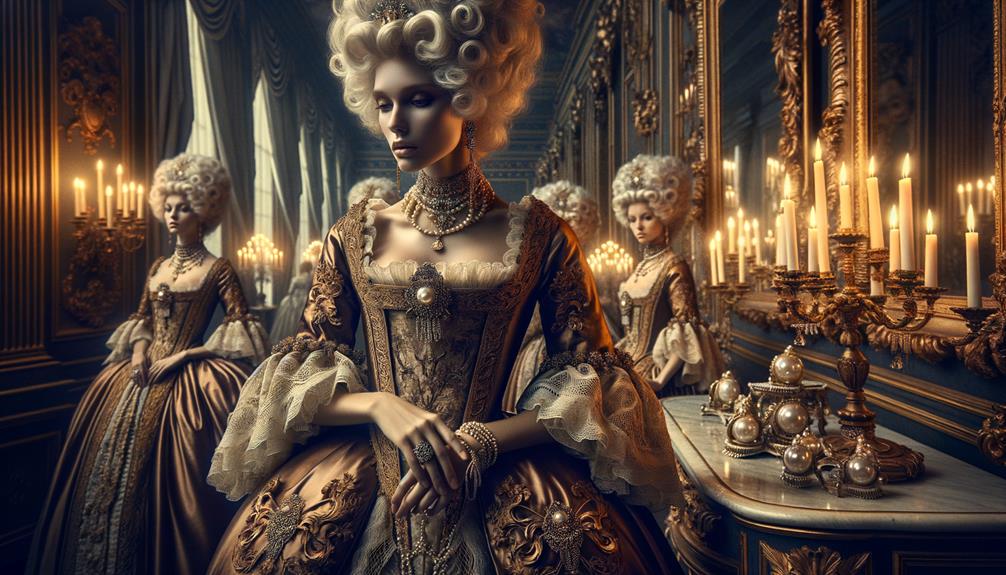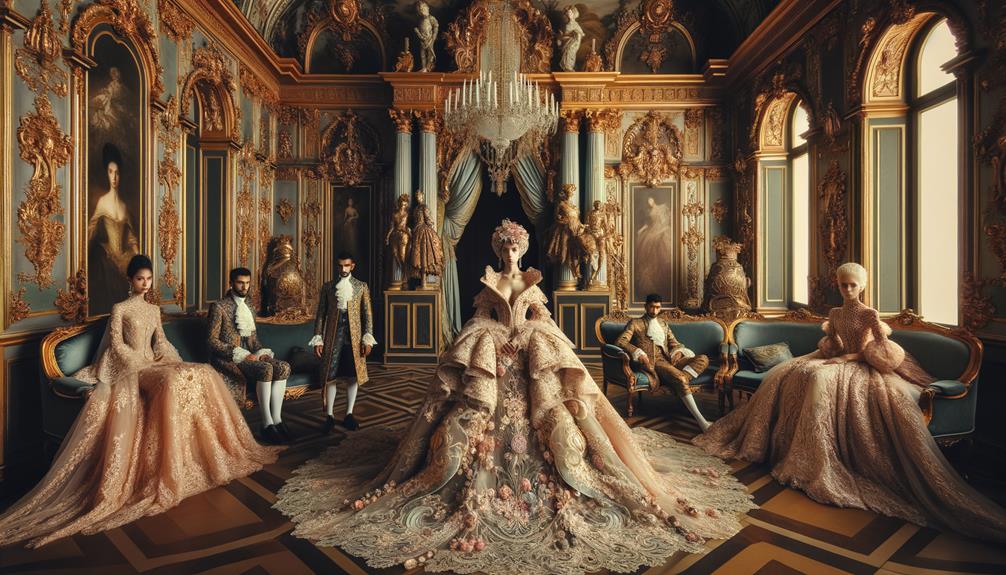Tricorne hats, with their distinctive upturned brims, were a defining accessory of the Baroque era. I've always been drawn to their elegant silhouette and the way they complemented the powdered wigs of the time. These hats, crafted from rich materials like beaver-felt, were more than just fashion statements – they were symbols of status and authority.
The triangular shape of the tricorne allowed for an unobstructed view, making them practical for military and naval officers. But they were also adorned with ornate details like ostrich plumes and metallic accents, showcasing the wealth and position of their wearers.
Today, the legacy of the tricorne hat lives on in modern reproductions, which still evoke the same timeless grandeur. To learn more about the intricate history and design of these captivating hats, simply keep reading.
Historical Significance
The tricorne hat was more than just a fashionable accessory during the Baroque and Rococo periods. It symbolized the social hierarchy and power structures of the time. This three-cornered hat was predominantly worn by the nobility, military personnel, and the upper classes, serving as a clear marker of sophistication and influence.
The evolution of the tricorne hat mirrored the shifting societal norms. It originated from the broader-brimmed styles of the 16th century, but was transformed to complement the elaborate wigs and intricate fashion trends of the Baroque era. The smaller size was practical, allowing easy removal when entering buildings, while still maintaining an air of elegance.
The tricorne's association with significant historical events, such as the Napoleonic Wars and the Thirty Years' War, adds depth to its narrative. This hat was not merely an accessory, but a witness to history, evolving with each epoch to reflect the changing tides of power and style. It chronicles the enduring impact of Baroque costume on our understanding of historical fashion.
Design and Structure
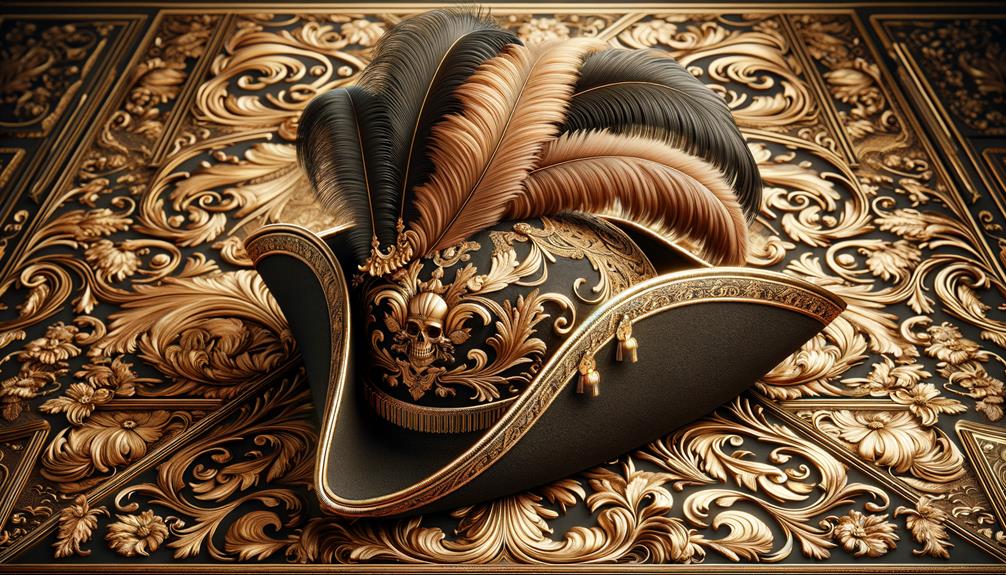
The design and structure of tricorne hats reveal a meticulous craftsmanship that balanced functionality with elegance. Each hat, with its distinctive triangular shape and three upturned sides, was more than just an accessory; it was a statement. Crafted from high-quality animal fibers, these hats often utilized luxurious beaver-hair felt or more accessible wool felt, each material lending its unique texture and durability.
What stands out the most is how the upwardly turned brims were not just for show. They elegantly framed the elaborate wigs gentlemen of the period wore, enhancing the overall silhouette while allowing for an unobstructed view. This clever design was as much about practicality as it was about style.
Mini tricorn hats also made their mark, offering a compact yet equally sophisticated alternative. These smaller versions maintained the characteristic structure but allowed for more flexibility in personal expression. As the exploration continues, it's clear that the tricorne was a symbol of power and authority, yet its design was deeply rooted in a need for sophisticated function. The delicate balance between these elements is what makes the tricorne an enduring icon of Baroque fashion.
Decorative Elements
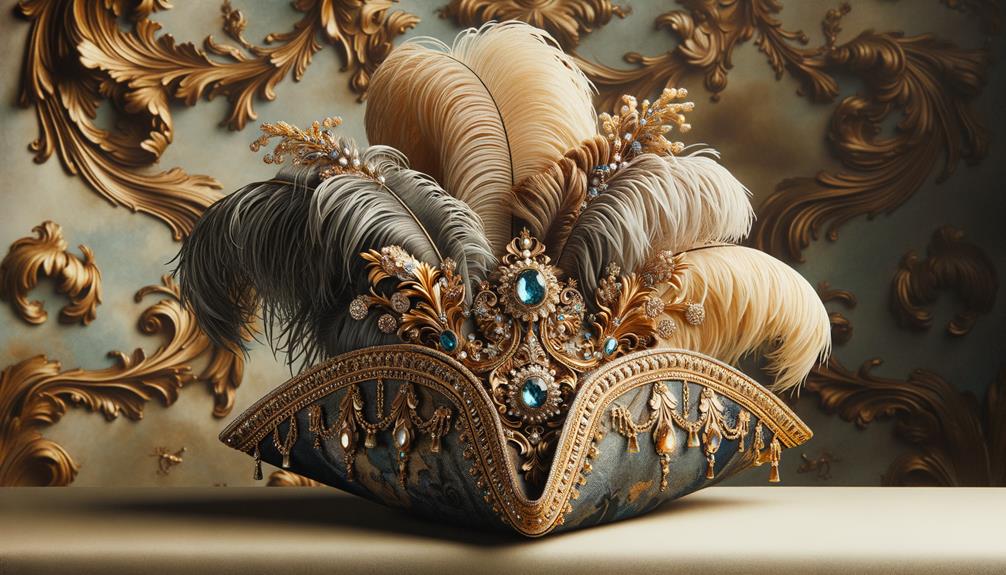
When I examine the intricate decorative elements of Baroque tricorne hats, I'm in awe of how meticulously each feather, ribbon, and metallic accent was chosen to showcase the wearer's wealth and status. The attention to detail is astounding, with every ostrich plume and silk trim telling a story of grandeur and elegance. It's fascinating to see how these elements were not just for show but a deliberate statement of one's place in society.
| Element | Material | Purpose |
|---|---|---|
| Feathers | Ostrich plumes | Convey a sense of grandeur |
| Ribbons | Silk | Provide a luxurious texture |
| Metallic accents | Gold and silver | Indicate the wearer's wealth |
| Embroidered patterns | Silk threads | Add a personalized touch |
The Marie Antoinette Hat, for instance, epitomized this lavishness with its vibrant hues of red, blue, and gold, making bold fashion statements. Such vibrant colors weren't merely decorative; they were strategic, designed to catch the eye and highlight one's prominence. The placement of each embellishment was a calculated effort to maintain balance and aesthetic appeal. It's this blend of artistry and social signaling that makes Baroque tricorne hats a hallmark of an era where fashion was synonymous with innovation.
Cultural Associations
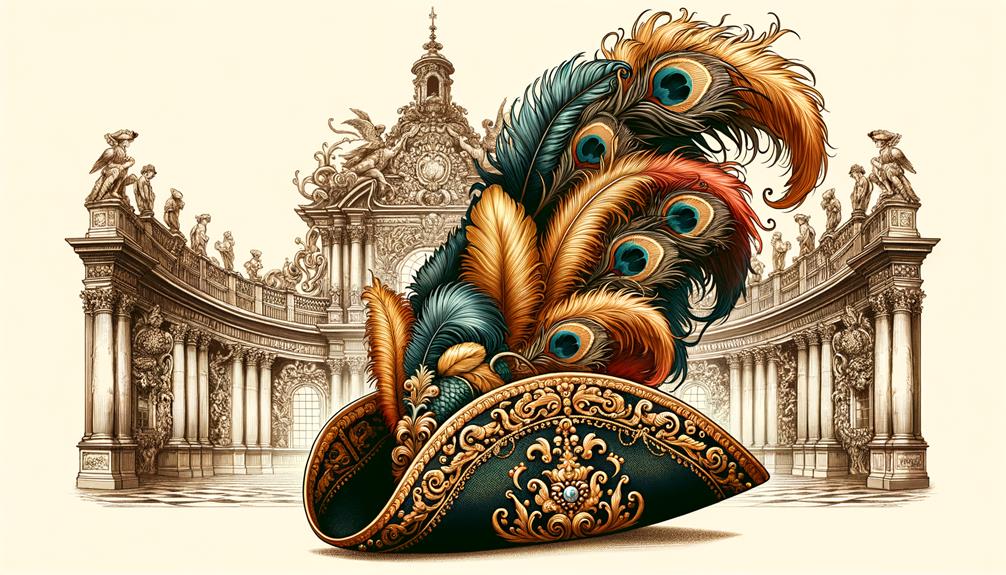
Tricorne hats, with their distinctive three-cornered design and elaborate decorations, were more than just fashion statements – they reflected the social and cultural hierarchy of the Baroque and Rococo eras. As I explore the cultural significance of this iconic headwear, I'm struck by how it embodied the essence of its time.
These hats weren't mere accessories – they were symbols of authority and status. Military and naval officers wore tricornes to signal their power and command, visually cueing their role in European politics and warfare. The hat's shape, evolved from the broad-brimmed designs of the 16th century, was a canvas for opulent embellishments – feathers, ribbons, and intricate trims – that showcased wealth and adherence to the prevailing artistic trends.
Government officials and aristocrats also donned tricornes, further embedding them within the social fabric. Each hat told a story of its wearer's position in the hierarchy, their taste, and their allegiance to the artistic movements of the era. The tricorne's association with historical conflicts, like the Napoleonic Wars and the Thirty Years' War, adds layers of meaning, making it a potent symbol of power, conflict, and legacy.
Modern Reproductions
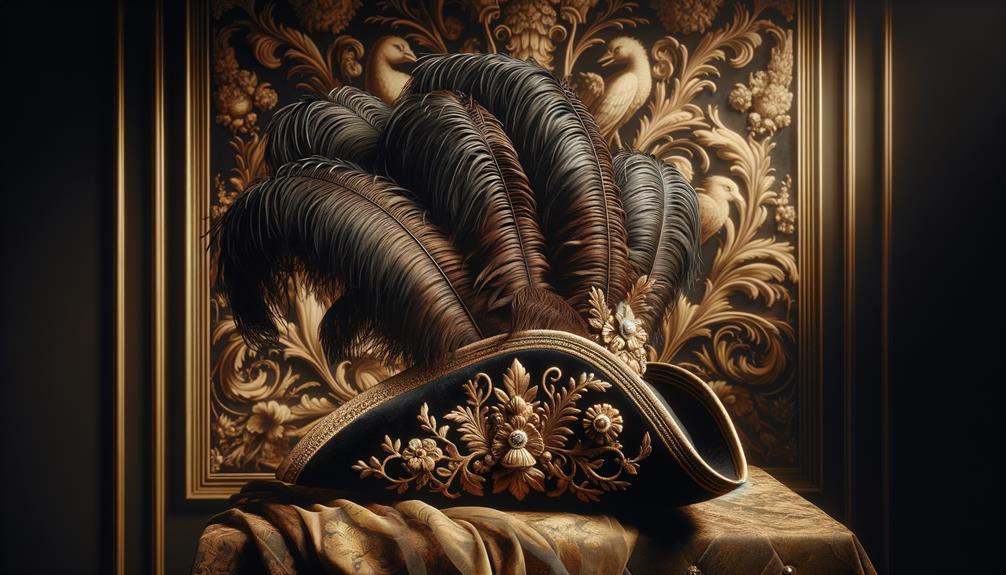
Exploring the fascinating world of modern tricorne hats, I'm captivated by how these beautifully crafted pieces capture the essence of Baroque opulence while seamlessly integrating with contemporary fashion. Crafted from high-quality felt, these hats often feature intricate trims and embellishments that pay homage to their historical counterparts. Yet, they also boast modern conveniences like adjustable chin straps, allowing for a more personalized fit – something the original wearers could only dream of.
What's particularly intriguing is how these tricorne hats, with their 5-inch diameters, manage to accommodate most adult head sizes without compromising on style. While they may not rival the modern elegance of a top hat, they undoubtedly bring a unique and fashionable flair to any event they grace.
Four aspects that make these modern reproductions so appealing:
- Material Quality: The use of high-quality felt ensures both durability and a luxurious feel.
- Design: Decorative trims and embellishments add an authentic Baroque touch, evoking a sense of historical grandeur.
- Versatility: Perfect for costume parties, historical reenactments, and themed events, offering endless opportunities for creative expression.
- Care Instructions: Easy maintenance through spot cleaning and proper storage, making them a practical choice for today's diverse fashion landscape.
As I observe these modern tricorne hats, I can't help but admire how they seamlessly bridge the gap between the past and the present, offering a unique and fashionable tribute to a bygone era.
Styling Tips
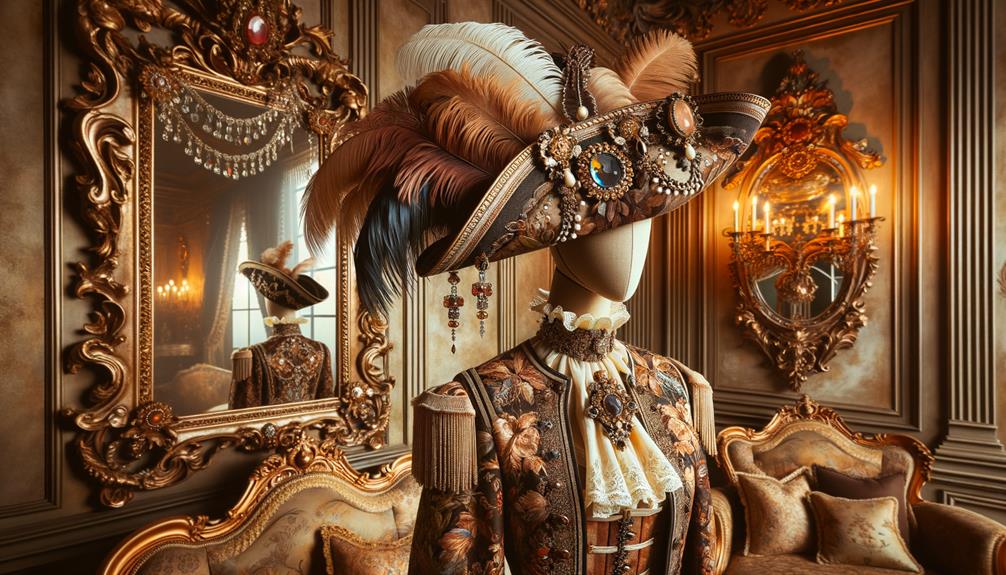
In my experience, wearing a baroque tricorne hat with a frilly collared shirt, breeches, and knee-high boots instantly transports one to the grandeur of the 17th and 18th centuries. This ensemble, which is both timeless and evocative, suits both men and women aiming for historical accuracy in their costume.
For those seeking a more adventurous look, try angling the hat forward. Combined with a billowing white shirt and sash, it creates a dashing, swashbuckling pirate aesthetic. This style isn't just for men; women can also embrace this daring persona, adding a unique twist to their costume.
To channel the aristocratic gentlemen of the baroque and rococo periods, wear the tricorne hat with a long wig or curled locks. This detail, though subtle, dramatically enhances the hat's regal aura. Complementing this look with intricate jewelry, lace accents, or decorative embellishments ensures a cohesive and polished ensemble.
Frequently Asked Questions
Why Did People Stop Wearing Tricorn Hats?
People stopped wearing tricorn hats because they became impractical and outdated. As society embraced new styles and ideas, simpler, mass-produced hats became more appealing. The complex structure and upkeep required for tricorns just didn't fit the efficient, modern era people were moving towards. Tricorns were overtaken by more practical and accessible headwear options that aligned better with the changing times.
What Was the Point of a Tricorn Hat?
Tricorn hats were a popular choice for many people in the 17th and 18th centuries. They offered practical benefits, providing protection from the elements while also conveying an air of sophistication. The distinctive three-cornered shape allowed the hat to be easily removed, making it convenient for those on the move.
Beyond their functionality, tricorn hats became a status symbol. The high-quality materials and intricate designs reflected the wearer's social standing and wealth. The hats were often adorned with decorative elements, further enhancing their visual appeal and signaling the owner's prominence.
What Is the Difference Between a Bicorne and a Tricorne?
The key difference between a bicorne and a tricorne hat is the number of upturned sides. A bicorne has two upturned sides, while a tricorne has three. These distinct designs served practical and stylistic purposes.
The bicorne, with its two upturned sides, was a popular military and civilian hat style in the 18th and 19th centuries. Its shape helped shed rain and provided shade for the wearer's eyes. The tricorne, on the other hand, had three upturned sides, giving it a more dramatic and commanding appearance. This style was closely associated with military uniforms and formal attire during the same era.
Both the bicorne and tricorne evolved from the broad-brimmed hats worn in earlier periods. The specific number of upturned sides reflected the preferences and symbolism of different cultures and social classes. While the bicorne was more practical, the tricorne conveyed a sense of authority and prestige.
Why Did Sailors Wear Tricorn Hats?
Why did sailors wear tricorn hats? It turns out there were some practical reasons. The hats helped keep sailors dry, as they were made of water-resistant materials. They were also easy to remove in the cramped spaces on ships. And the distinctive shape of the tricorn hat was a symbol of a sailor's status and maritime tradition. So it was a blend of functionality and maritime style that led to the widespread adoption of the tricorn hat among sailors.
Conclusion
The tricorne hat has certainly made a comeback, and I can't help but reflect on its journey. This striking accessory, with its intricate folds and rich history, truly captures the elegance of the Baroque era. From its decorative elements to modern interpretations, the tricorne has weathered the test of time, blending the past and present. As I observe its resurgence in fashion, I realize it's not just a hat – it's a statement, a connection to a bygone era that still resonates today.
The tricorne's design has evolved, yet its allure remains. It's a testament to the enduring appeal of classic style. Whether adorning the heads of historical figures or contemporary trendsetters, the tricorne continues to captivate and inspire. Its versatility allows it to transcend eras, seamlessly transitioning from the courts of Europe to the modern runway. This hat is more than just a fashion statement; it's a tangible link to a bygone time, a reminder that timeless elegance never goes out of style.



